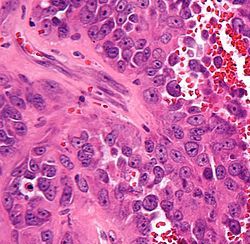Pazopanib Regimen Misses Endpoints in Leiomyosarcoma Study
Although the addition of pazopanib (Votrient) to gemcitabine in the second-line treatment of patients with metastatic or relapsed uterine or soft tissue leiomyosarcomas demonstrated disease control in the majority of patients, statistical endpoints were not met in the phase II UNICANCER SARCOMA 11 study, according to results reported at the 2017 ESMO Congress.

Although the addition of pazopanib (Votrient) to gemcitabine in the second-line treatment of patients with metastatic or relapsed uterine or soft tissue leiomyosarcomas demonstrated disease control in the majority of patients, statistical endpoints were not met in the phase II UNICANCER SARCOMA 11 study, according to results reported at the 2017 ESMO Congress.
Leiomyosarcomas account for 10% to 15% of soft tissue and visceral sarcomas, and occur most frequently in the uterus. Since they are only moderately chemosensitive, pazopanib was added to gemcitabine to increase the clinical activity, according to Patricia Pautier, MD, Institute Gustave Roussy, in Villejuif, France.
“The study results are negative in the intent-to-to treat population but nearly positive when considering the results of the per-protocol population,” said Pautier.
Pazopanib (Votrient) is a potent multitargeted tyrosine kinase inhibitor that blocks tumor growth and inhibits angiogenesis. Both the FDA and the European Commission have approved pazopanib for renal cell carcinoma and soft tissue sarcoma.
“Options in second-line therapy after anthracycline-based chemotherapy for metastatic/advanced disease include gemcitabine, trabectedin (Yondelis), and pazopanib monotherapy. Currently no combination therapy is better than monochemotherapy,” said Pautier.
The UNICANCER SARCOME 11 (NCT01442662) open-label multicenter single-group phase II study evaluated the efficacy and tolerance of gemcitabine plus pazopanib as second-line in adult patients with metastatic or relapsed uterine or soft tissue leiomyosarcomas who had failed anthracycline-based chemotherapy.
At 18 French centers, the study enrolled patients between 2011 and 2016 who had ECOG status ≤2 after failing first-line anthracycline chemotherapy. The patients were mostly women (85.8%), ECOG status 0 (63.5%), with a mean age of 59.8 years. Patients were required to have measurable disease by RECIST 1.1 at study entry.
The location was uterine in 61% of patients and extra-uterine in the remaining patients. At study entry, 88.6% of patients had metastatic disease with 82.9% of patients having lung metastases, 41% had liver, 21% had bone, and 98.1% had “other” metastases.
Gemcitabine at 1000 mg/m2 on days 1 and 8 of each 21-day cycle was administered for a maximum of 8 cycles, in combination with oral daily pazopanib at 800 mg/day, until disease progression or unacceptable toxicity. Tumor response by RECIST was assessed every 6 weeks.
The primary endpoint was the 9-month progression-free survival (PFS) rate. Unacceptable 9-month PFS rates were defined as ≤32% with a median PFS of 5.5 months in the intent-to-treat (ITT) population and promising rates were set at 44% with median PFS of 7.5 months. Secondary objectives included disease control rate (complete response [CR] + partial response [PR] + stable disease [SD]), overall survival, and toxicity.
Patients received pazopanib plus gemcitabine for a median of 3.8  months and 40 (38%) patients completed the entire 8 cycles of the combination. The median treatment duration was 4.2 months (range, 1.9-6.2).
The 9-month PFS rate was 32.1% (95% CI, 23.2-41.4) in the 105 patients in the ITT population and 34.6% (95% CI, 24.9-44.4) in the 95 patients in the per-protocol population. In the respective populations, median PFS was 6.5  months (95% CI, 5.6-8.2) and 7.1 months (95% CI, 5.7-8.3).
The median follow-up was 12.3 and 12.2 months in the respective populations.
The best treatment response in the ITT population included 1 CR, 22 PRs (21.8%), and 64 patients (63.4%) with SD. Fourteen patients (13.9%) experienced progressive disease.
However, the overall response at 12 weeks in the 67 per-protocol patients included no CR, 11 PRs (16.4%), 9 SD (13.4%), 9 patients (13.4%) with progression, and 2 (3.0%) unevaluable patients, providing a 12-week control rate of 83.6%.
Session discussant Mikael Eriksson MD, department of Oncology, Lund University in Sweden remarked, “Pazopanib and gemcitabine is an interesting combination in leiomyosarcomas that should not be ruled out yet.”
Grade 3/4 adverse events occurring in more than 30% of patients included neutropenia in 76 patients (72.4%), leucopenia in 59 (56.2%), and thrombocytopenia in 40 (38.1%).
“The combination was well-tolerated,” commented Pautier, “no new safety signals were raised.”
Reference:
Tutt A, Robson M, Garber JE, et al. Oral poly(ADP-ribose) polymerase inhibitor olaparib in patients with BRCA1 or BRCA2 mutations and advanced breast cancer: a proof-of-concept trial.Lancet. 2010;376(9737):235-244. doi:10.1016/S0140-6736(10)60892-6.